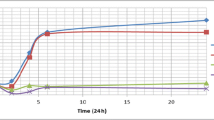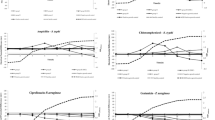Abstract
According to the instantaneous growth rate (dN/dt) of E. coli CVCC249 growing in batch culture, the entire growth progress was distinguished into four phases: accelerating growth phase, constant growth phase, decelerating growth phase and declining phase, in each of which obvious variation in physiological and biochemical properties was detected, including total DNA, total protein, and MTT-dehydrogenase activity, etc., that led to difference in their antibiotic susceptivity. Antibiotic susceptivity of the population sampled from each phase was tested by Concentration-killing Curve (CKC) approach following the formula N=N0/{1+exp[r·(x-BC50)]}, showing as normal distribution at the individual cell level for an internal population, in which the median bactericidal concentration BC50 represents the mean level of susceptivity, while the bactericidal span BC1−99=(2lnN0)/r indicates the variation degree of the antibiotic susceptivity. Furthermore, tested by CKC approach, the antibiotic susceptivity of E. coli CVCC249 population in each physiological phase to gentamicin or enoxacin was various: susceptivity of the population in the constant growth phase and declining phase all increased compared with that in the accelerating growth phase for gentamicin but declined for enoxacin. The primary investigations revealed that the physiological phase should be taken into account in the context of antibiotic susceptivity and research into antimicrobial mechanism. However there are few reports concerned with this study. Further research using different kinds of antibiotics with synchronized continuous culture of different bacterial strains is required.
Similar content being viewed by others
References
Scavizzi M R, Labia R, Petitjean O J, et al. Antimicrobial susceptivity test: from bacterial population analysis to therapy. Int J Antimicrob Agents, 2002, 19: 9–20, 11814763, 10.1016/S0924-8579(01)00467-8, 1:CAS:528:DC%2BD38Xos1ertQ%3D%3D
National Committee for Clinical Laboratory Standards. Performance Standards for Antimicrobial Disk and Dilution Tolerance Tests for Bacteria Isolated from Animals: Approved Standard, 2nd ed. NCCLS document M31-A2, Wayne, PA, USA, 2002
Liu Y Q, Zhang Y Z, Gao P J. Novel Concentration-Killing Curve method for estimation of bactericidal potency of antibiotics in an in vitro dynamic model. Antimicrob Agents Chemother, 2004, 48: 3884–3891, 15388449, 10.1128/AAC.48.10.3884-3891.2004, 1:CAS:528:DC%2BD2cXosVygsbw%3D
Cooper S. Bacterial Growth and Division, Biochemistry and Regulation of Prokaryotic and Eukaryotic Division Cycles. New York: Academic Press, 1991
Kim L. Programmed death in bacteria. Microbiol Mol Biol Revs, 2000, 64: 503–514, 10.1128/MMBR.64.3.503-514.2000
Zhang H Q, Liu Y Q, Gao P J. A novel approach for estimating growth phases and parameters of bacterial population in batch culture. Sci China Ser C-Life Sci, 2006, 49(2): 130–140, 10.1007/s11427-006-0130-6, 1:CAS:528:DC%2BD28XivVOhtL0%3D
Zhang H Q, L L, Gao P J. Effect of the population heterogeneity on growth behavior and its estimation. Sci China Ser C-Life Sci, 2007, 50(4) 535–547, 10.1007/s11427-007-0057-6
Zhang H B, Ding H S. Heterogeneity of bacterial population. Microbiology, 2001, 28(2): 93–96, 1:CAS:528:DC%2BD3MXktVGis7g%3D
Holmstrøm K, Tolker-Nielsen T, Molin S. Physiological states of individual Salmonella typhimurium cells monitored by in situ re-verse transcription-PCR. J Bacteriol, 1999, 181: 1733–1738, 10074064
Tolker-Nielsen T, Holmstrøm K, Molin S. Visualization of specific gene expression in Salmonella typhimurium by in situ PCR. Appl Env Microbiol, 1997, 63: 4196–4203, 1:CAS:528:DyaK2sXnt12nsbw%3D
Konopka A. Microbial physiological state at low growth rate in natural and engineered ecosystems. Curr Opin Microbiol, 2000, 3: 244–247, 10851156, 10.1016/S1369-5274(00)00083-7, 1:STN:280:DC%2BD3czhtFCqug%3D%3D
Kim W, Surette M G. Swarming populations of Salmonella represent a unique physiological state coupled to multiple mechanisms of antibiotic resistance. Biol Proced Online, 2003, 5: 189–196, 14615815, 10.1251/bpo61, 1:CAS:528:DC%2BD3sXptV2nsbs%3D
Kim W, Surette M G. Metabolic differentiation in actively swarming Salmonella. Mol Microbiol, 2004, 54: 702–714, 15491361, 10.1111/j.1365-2958.2004.04295.x, 1:CAS:528:DC%2BD2cXpslKkt7Y%3D
Cuenca-Estrella M T, Díaz-Guerra M, Mellado E, et al. Influence of glucose supplementation and inoculum size on growth kinetics and antifungal tolerance testing of Candida spp. Clin Microbiol, 2001, 39: 525–532, 10.1128/JCM.39.2.525-532.2001, 1:CAS:528:DC%2BD3MXhtlGrtb8%3D
Mueller M, Pena A, Derendorf H. Issues in pharmacokinetics and pharmacodynamics of anti-infective agents: Kill curves vs. MIC. Antimicrob Agents Chemother, 2004, 48: 369–377, 14742182, 10.1128/AAC.48.2.369-377.2004, 1:CAS:528:DC%2BD2cXhtFGls78%3D
Jin Z H, Lin J P, Qin P L. Kinetic model of teicoplanin fermentation by Actionplanes Teichomyceticus. J Biomath (in Chinese), 2004, 19: 10–108
Sat B, Hazan R, Fisher T, et al. Programmed cell death in Escherichia coli: Some antibiotics can trigger mazEF lethality. J Bacteriol, 2001, 183: 2041–2045, 11222603, 10.1128/JB.183.6.2041-2045.2001, 1:CAS:528:DC%2BD3MXhvVeksbY%3D
Keren I, Shah D, Spoering A, et al. Specialized persister cells and the mechanism of multidrug tolerance in Escherichia coli. J Bacteriol, 2004, 186: 8172–8180, 15576765, 10.1128/JB.186.24.8172-8180.2004, 1:CAS:528:DC%2BD2cXhtFSgsrzI
Keren I, Kaldalu N, Spoeting A, et al. Persister cells and tolerance to antimicrobials. FEMS Microbiol Lett, 2004, 230: 13–18, 14734160, 10.1016/S0378-1097(03)00856-5, 1:CAS:528:DC%2BD2cXltVymtQ%3D%3D
Levin B R. Noninherited resistance to antibiotics. Science, 2004, 305: 1578–1579, 15361616, 10.1126/science.1103077, 1:CAS:528:DC%2BD2cXnsFWhurk%3D
Tuomanen E, Durack D T, Tomasz A. Antibiotic tolerance among clinical isolates of bacteria. Antimicrob Agents Chemother, 1986, 30: 521–527, 3539006, 1:CAS:528:DyaL28XmtVGrsr4%3D
Liu S. Continuing observation and a new life model of bacterial growth in liquid medium. Sci China Ser C-Life Sci (in Chinese), 1999, 29: 571–579
Chen D J. Antibacterial and Bacterial Reisitance. Shanghai: East China University of Science and Technology Press, 2001
Author information
Authors and Affiliations
Corresponding author
Additional information
Supported by the Natural Science Foundation of Shandong Province, China (Grant No. Y2005C58), the Natural Key Technology R&D Program of China (Grant No. 2006BAK02A03-6) and the Youth Scientific Research Foundation of Shandong Academy of Agricultural Science (2005YQ035)
Rights and permissions
About this article
Cite this article
Liu, Y., Zhang, H., Shen, J. et al. Effect of physiological heterogeneity of E. coli population on antibiotic susceptivity test. SCI CHINA SER C 50, 808–813 (2007). https://doi.org/10.1007/s11427-007-0091-4
Received:
Accepted:
Published:
Issue Date:
DOI: https://doi.org/10.1007/s11427-007-0091-4




